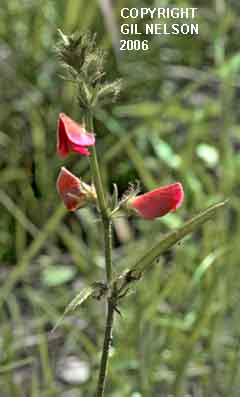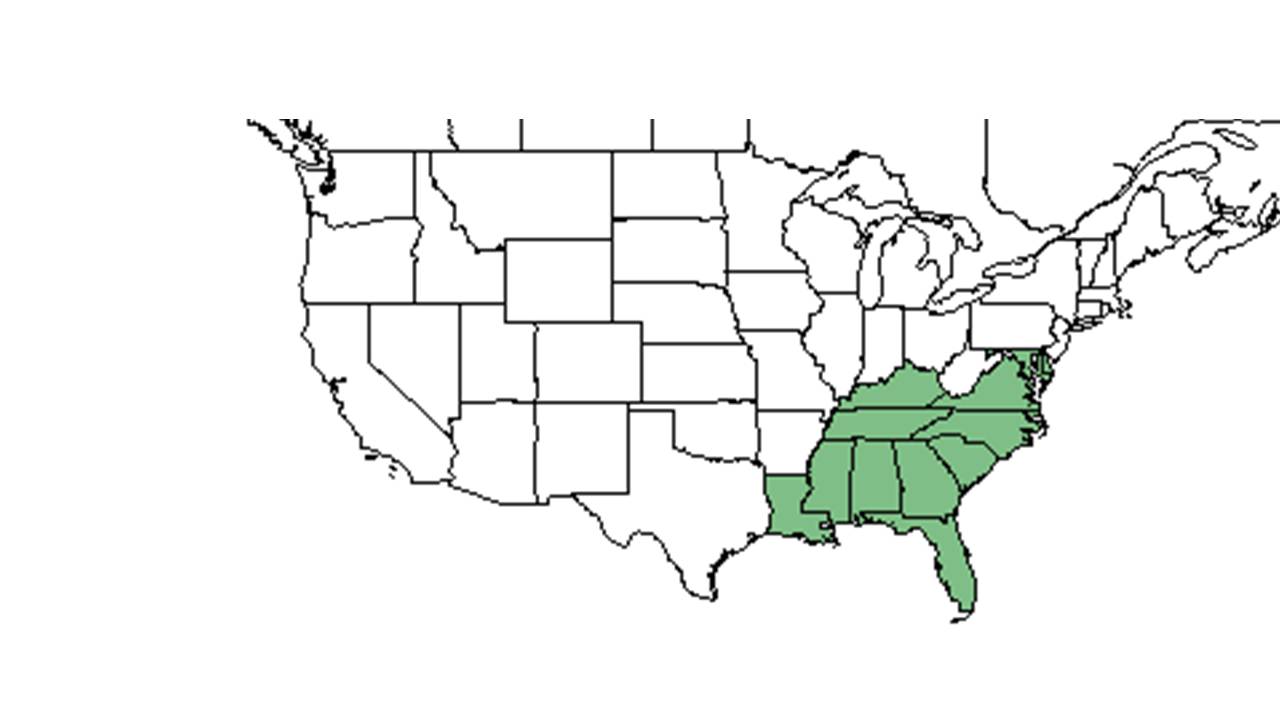Difference between revisions of "Tephrosia spicata"
(→Conservation and Management) |
Krobertson (talk | contribs) |
||
| Line 23: | Line 23: | ||
==Description== | ==Description== | ||
<!-- Basic life history facts such as annual/perrenial, monoecious/dioecious, root morphology, seed type, etc. --> | <!-- Basic life history facts such as annual/perrenial, monoecious/dioecious, root morphology, seed type, etc. --> | ||
| − | "Perennial herbs and shrubs with either monopodial or sympodial branching. Leaves odd-pinnate; leaflets 7-29 or rarely 1-41, entire, glabrous or pubescent above and always pubescent beneath, usually with prominent, parallel, secondary veins, estipellate, inflorescences terminal, axillary or apparently opposite a leaf, more or less racemose, with 2-10, papilionaceous, pedicellate flowers at each node with the cluster subtended by a bract and each pedicels subtended, 5-lobed, the lowers the long longest; petals clawed; stamens monadelphous or diadelphous. Legume sessile, linear, straight or slightly curved, usually compressed, nonseptate, dehiscing into 2 separate valves." | + | "Perennial herbs and shrubs with either monopodial or sympodial branching. Leaves odd-pinnate; leaflets 7-29 or rarely 1-41, entire, glabrous or pubescent above and always pubescent beneath, usually with prominent, parallel, secondary veins, estipellate, inflorescences terminal, axillary or apparently opposite a leaf, more or less racemose, with 2-10, papilionaceous, pedicellate flowers at each node with the cluster subtended by a bract and each pedicels subtended, 5-lobed, the lowers the long longest; petals clawed; stamens monadelphous or diadelphous. Legume sessile, linear, straight or slightly curved, usually compressed, nonseptate, dehiscing into 2 separate valves." <ref name="Radford et al 1964">Radford, Albert E., Harry E. Ahles, and C. Ritchie Bell. Manual of the Vascular Flora of the Carolinas. 1964, 1968. The University of North Carolina Press. 626. Print.</ref> |
| − | "Perennial herb from a cylindric taproot; stems decumbent to erect, mostly 3-6 dm long, densely pilose or occasionally sparsely appressed pubescent. Leaves 4-12 cm long; leaflets 9-17, oblong-obovate to obovate or elliptic, 1-2.7 (3.7) cm long, 6-14 mm wide, glabrous to finely pilose above, somewhat appressed to spreading short-pubescent to pilose below. Principal inflorescences appearing opposite the leaf or terminal, 4-60 cm long, usually longer than nearest leaf, erect or upwardly curving with a terete or angled peduncle and rachis with persistent, lanceolate to linear bracts; pedicels 1-8 mm long. Calyx 6-7 mm long, sparsely to more typically densely pilose or villous; petals at first white, turning pink then carmine (drying purplish), 1.2-1.7 cm long; stamens diadelphous. Legume 3-5 cm long, 4-6 mm broad, sparsely to moderately pubescent, trichomes more than 0.6 mm long." | + | "Perennial herb from a cylindric taproot; stems decumbent to erect, mostly 3-6 dm long, densely pilose or occasionally sparsely appressed pubescent. Leaves 4-12 cm long; leaflets 9-17, oblong-obovate to obovate or elliptic, 1-2.7 (3.7) cm long, 6-14 mm wide, glabrous to finely pilose above, somewhat appressed to spreading short-pubescent to pilose below. Principal inflorescences appearing opposite the leaf or terminal, 4-60 cm long, usually longer than nearest leaf, erect or upwardly curving with a terete or angled peduncle and rachis with persistent, lanceolate to linear bracts; pedicels 1-8 mm long. Calyx 6-7 mm long, sparsely to more typically densely pilose or villous; petals at first white, turning pink then carmine (drying purplish), 1.2-1.7 cm long; stamens diadelphous. Legume 3-5 cm long, 4-6 mm broad, sparsely to moderately pubescent, trichomes more than 0.6 mm long." <ref name="Radford et al 1964"/> |
==Distribution== | ==Distribution== | ||
==Ecology== | ==Ecology== | ||
===Habitat=== <!--Natural communities, human disturbed habitats, topography, hydrology, soils, light, fire regime requirements for removal of competition, etc.--> | ===Habitat=== <!--Natural communities, human disturbed habitats, topography, hydrology, soils, light, fire regime requirements for removal of competition, etc.--> | ||
| − | ''Tephrosia spicata'' can be found in coastal hammocks; wiregrass/pine communities; pine savannas; mixed hardwood forests; longleaf pine-turkey oak hills; turkey oak barrens; and longleaf pine scrub oak sand ridges | + | ''Tephrosia spicata'' can be found in coastal hammocks; wiregrass/pine communities; pine savannas; mixed hardwood forests; longleaf pine-turkey oak hills; turkey oak barrens; and longleaf pine scrub oak sand ridges. <ref name="FSU Herbarium">Florida State University Robert K. Godfrey Herbarium database. URL: [http://herbarium.bio.fsu.edu http://herbarium.bio.fsu.edu]. Last accessed: October 2015. Collectors: W.P. Adams, Loran C. Anderson, Wilson Baker, C. Ritchie Bell, WM. M. CanbyA.F. Clewell, K. Craddock Burks, H.S. Daoud, ,R.A. Davidson, J.A. Duke, J. Kevin England, R.K. Godfrey, J.B. Hilmon, S.C. Hood, Clarke Hudson, C. Jackson, Ed Keppner, Lisa Keppner, R. Komarek, Mabel Kral, R. Kral, O. Lakela, Richard S. Mitchell, R.A. Norris, Kevin Oakes, R.C. Phillips, Gwynn W. Ramsey, James D. Ray Jr., H.R. Reed, A.B. Seymour, Cecil Slaughter, R.F. Thorne, Rodie White, Mary Margaret Williams. States and Counties: Alabama: Geneva, Marengo. Florida: Alachua, Bay, Calhoun, Charlotte, Citrus, Duval, Franklin, Gadsden, Gulf, Hernando, Hillsborough, Jackson, Jefferson, Liberty, Leon, Madison, Marion, Pasco, Polk,Wakulla. Georgia: Grady, Thomas. Maryland: Salisbury. Mississippi: Forrest, Jackson, Marion, Newton, Ocean Springs, Pike, Poplarville. North Carolina: Rutherford, Wayne. South Carolina: Marion. Virginia: Greensville. Compiled by Tall Timbers Research Station and Land Conservancy.</ref> <ref name=KK/> It has been found in human disturbed areas such as railroad beds, cut over pine flatwoods, and roadsides. Soil types include loamy sand, sandy loam, clay soil, sand, sandy peat, and sandy clay. <ref name="FSU Herbarium">Florida State University Robert K. Godfrey Herbarium database. URL: [http://herbarium.bio.fsu.edu http://herbarium.bio.fsu.edu]. Last accessed: October 2015. Collectors: W.P. Adams, Loran C. Anderson, Wilson Baker, C. Ritchie Bell, WM. M. CanbyA.F. Clewell, K. Craddock Burks, H.S. Daoud, ,R.A. Davidson, J.A. Duke, J. Kevin England, R.K. Godfrey, J.B. Hilmon, S.C. Hood, Clarke Hudson, C. Jackson, Ed Keppner, Lisa Keppner, R. Komarek, Mabel Kral, R. Kral, O. Lakela, Richard S. Mitchell, R.A. Norris, Kevin Oakes, R.C. Phillips, Gwynn W. Ramsey, James D. Ray Jr., H.R. Reed, A.B. Seymour, Cecil Slaughter, R.F. Thorne, Rodie White, Mary Margaret Williams. States and Counties: Alabama: Geneva, Marengo. Florida: Alachua, Bay, Calhoun, Charlotte, Citrus, Duval, Franklin, Gadsden, Gulf, Hernando, Hillsborough, Jackson, Jefferson, Liberty, Leon, Madison, Marion, Pasco, Polk,Wakulla. Georgia: Grady, Thomas. Maryland: Salisbury. Mississippi: Forrest, Jackson, Marion, Newton, Ocean Springs, Pike, Poplarville. North Carolina: Rutherford, Wayne. South Carolina: Marion. Virginia: Greensville. Compiled by Tall Timbers Research Station and Land Conservancy.</ref> Associated species include ''Phlox floridana, Calamintha dentata, Canna, Sambucus, Aristida stricta, Rhynchospora, Tephrosia floridana'' and ''T. chrysophylla.'' <ref name="FSU Herbarium"/> |
===Phenology=== <!--Timing off flowering, fruiting, seed dispersal, and environmental triggers. Cite PanFlora website if appropriate: http://www.gilnelson.com/PanFlora/ --> | ===Phenology=== <!--Timing off flowering, fruiting, seed dispersal, and environmental triggers. Cite PanFlora website if appropriate: http://www.gilnelson.com/PanFlora/ --> | ||
| − | It has been recorded flowering and fruiting May through October | + | It has been recorded flowering and fruiting May through October. <ref name="FSU Herbarium"/> |
===Seed dispersal=== | ===Seed dispersal=== | ||
| Line 39: | Line 39: | ||
<!--===Seed bank and germination===--> | <!--===Seed bank and germination===--> | ||
===Fire ecology=== <!--Fire tolerance, fire dependence, adaptive fire responses--> | ===Fire ecology=== <!--Fire tolerance, fire dependence, adaptive fire responses--> | ||
| − | It has been found in recently burned longleaf pine communities | + | It has been found in recently burned longleaf pine communities. <ref name="FSU Herbarium"/> |
<!--===Pollination===--> | <!--===Pollination===--> | ||
<!--===Use by animals==--> <!--Herbivory, granivory, insect hosting, etc.--> | <!--===Use by animals==--> <!--Herbivory, granivory, insect hosting, etc.--> | ||
| Line 51: | Line 51: | ||
==References and notes== | ==References and notes== | ||
| − | |||
| − | |||
| − | |||
Revision as of 09:21, 9 August 2016
| Tephrosia spicata | |
|---|---|

| |
| Photo taken by Gil Nelson | |
| Scientific classification | |
| Kingdom: | Plantae |
| Division: | Magnoliophyta – Flowering plants |
| Class: | Magnoliopsida – Dicotyledons |
| Order: | Fabales |
| Family: | Fabaceae ⁄ Leguminosae |
| Genus: | Tephrosia |
| Species: | T. spicata |
| Binomial name | |
| Tephrosia spicata (Walter) Torr. & A. Gray | |

| |
| Natural range of Tephrosia spicata from USDA NRCS Plants Database. | |
Common name: spiked hoarypea
Contents
Taxonomic notes
Synonyms: Tephrosia spicata var. semitonsa Fernald; T. spicata var. spicata; Cracca spicata (Walter) Kuntze
Description
"Perennial herbs and shrubs with either monopodial or sympodial branching. Leaves odd-pinnate; leaflets 7-29 or rarely 1-41, entire, glabrous or pubescent above and always pubescent beneath, usually with prominent, parallel, secondary veins, estipellate, inflorescences terminal, axillary or apparently opposite a leaf, more or less racemose, with 2-10, papilionaceous, pedicellate flowers at each node with the cluster subtended by a bract and each pedicels subtended, 5-lobed, the lowers the long longest; petals clawed; stamens monadelphous or diadelphous. Legume sessile, linear, straight or slightly curved, usually compressed, nonseptate, dehiscing into 2 separate valves." [1]
"Perennial herb from a cylindric taproot; stems decumbent to erect, mostly 3-6 dm long, densely pilose or occasionally sparsely appressed pubescent. Leaves 4-12 cm long; leaflets 9-17, oblong-obovate to obovate or elliptic, 1-2.7 (3.7) cm long, 6-14 mm wide, glabrous to finely pilose above, somewhat appressed to spreading short-pubescent to pilose below. Principal inflorescences appearing opposite the leaf or terminal, 4-60 cm long, usually longer than nearest leaf, erect or upwardly curving with a terete or angled peduncle and rachis with persistent, lanceolate to linear bracts; pedicels 1-8 mm long. Calyx 6-7 mm long, sparsely to more typically densely pilose or villous; petals at first white, turning pink then carmine (drying purplish), 1.2-1.7 cm long; stamens diadelphous. Legume 3-5 cm long, 4-6 mm broad, sparsely to moderately pubescent, trichomes more than 0.6 mm long." [1]
Distribution
Ecology
Habitat
Tephrosia spicata can be found in coastal hammocks; wiregrass/pine communities; pine savannas; mixed hardwood forests; longleaf pine-turkey oak hills; turkey oak barrens; and longleaf pine scrub oak sand ridges. [2] [3] It has been found in human disturbed areas such as railroad beds, cut over pine flatwoods, and roadsides. Soil types include loamy sand, sandy loam, clay soil, sand, sandy peat, and sandy clay. [2] Associated species include Phlox floridana, Calamintha dentata, Canna, Sambucus, Aristida stricta, Rhynchospora, Tephrosia floridana and T. chrysophylla. [2]
Phenology
It has been recorded flowering and fruiting May through October. [2]
Seed dispersal
According to Kay Kirkman, a plant ecologist, this species disperses by gravity. [3]
Fire ecology
It has been found in recently burned longleaf pine communities. [2]
Conservation and management
Cultivation and restoration
Photo Gallery
References and notes
- ↑ 1.0 1.1 Radford, Albert E., Harry E. Ahles, and C. Ritchie Bell. Manual of the Vascular Flora of the Carolinas. 1964, 1968. The University of North Carolina Press. 626. Print.
- ↑ 2.0 2.1 2.2 2.3 2.4 Florida State University Robert K. Godfrey Herbarium database. URL: http://herbarium.bio.fsu.edu. Last accessed: October 2015. Collectors: W.P. Adams, Loran C. Anderson, Wilson Baker, C. Ritchie Bell, WM. M. CanbyA.F. Clewell, K. Craddock Burks, H.S. Daoud, ,R.A. Davidson, J.A. Duke, J. Kevin England, R.K. Godfrey, J.B. Hilmon, S.C. Hood, Clarke Hudson, C. Jackson, Ed Keppner, Lisa Keppner, R. Komarek, Mabel Kral, R. Kral, O. Lakela, Richard S. Mitchell, R.A. Norris, Kevin Oakes, R.C. Phillips, Gwynn W. Ramsey, James D. Ray Jr., H.R. Reed, A.B. Seymour, Cecil Slaughter, R.F. Thorne, Rodie White, Mary Margaret Williams. States and Counties: Alabama: Geneva, Marengo. Florida: Alachua, Bay, Calhoun, Charlotte, Citrus, Duval, Franklin, Gadsden, Gulf, Hernando, Hillsborough, Jackson, Jefferson, Liberty, Leon, Madison, Marion, Pasco, Polk,Wakulla. Georgia: Grady, Thomas. Maryland: Salisbury. Mississippi: Forrest, Jackson, Marion, Newton, Ocean Springs, Pike, Poplarville. North Carolina: Rutherford, Wayne. South Carolina: Marion. Virginia: Greensville. Compiled by Tall Timbers Research Station and Land Conservancy.
- ↑ 3.0 3.1 Kay Kirkman, unpublished data, 2015.